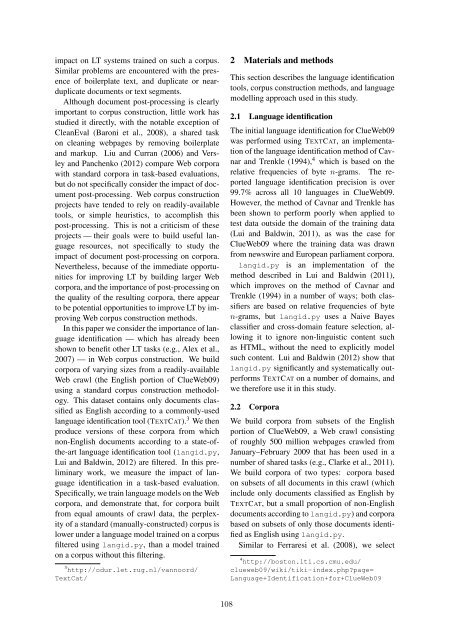Full proceedings volume - Australasian Language Technology ...
Full proceedings volume - Australasian Language Technology ...
Full proceedings volume - Australasian Language Technology ...
Create successful ePaper yourself
Turn your PDF publications into a flip-book with our unique Google optimized e-Paper software.
impact on LT systems trained on such a corpus.<br />
Similar problems are encountered with the presence<br />
of boilerplate text, and duplicate or nearduplicate<br />
documents or text segments.<br />
Although document post-processing is clearly<br />
important to corpus construction, little work has<br />
studied it directly, with the notable exception of<br />
CleanEval (Baroni et al., 2008), a shared task<br />
on cleaning webpages by removing boilerplate<br />
and markup. Liu and Curran (2006) and Versley<br />
and Panchenko (2012) compare Web corpora<br />
with standard corpora in task-based evaluations,<br />
but do not specifically consider the impact of document<br />
post-processing. Web corpus construction<br />
projects have tended to rely on readily-available<br />
tools, or simple heuristics, to accomplish this<br />
post-processing. This is not a criticism of these<br />
projects — their goals were to build useful language<br />
resources, not specifically to study the<br />
impact of document post-processing on corpora.<br />
Nevertheless, because of the immediate opportunities<br />
for improving LT by building larger Web<br />
corpora, and the importance of post-processing on<br />
the quality of the resulting corpora, there appear<br />
to be potential opportunities to improve LT by improving<br />
Web corpus construction methods.<br />
In this paper we consider the importance of language<br />
identification — which has already been<br />
shown to benefit other LT tasks (e.g., Alex et al.,<br />
2007) — in Web corpus construction. We build<br />
corpora of varying sizes from a readily-available<br />
Web crawl (the English portion of ClueWeb09)<br />
using a standard corpus construction methodology.<br />
This dataset contains only documents classified<br />
as English according to a commonly-used<br />
language identification tool (TEXTCAT). 3 We then<br />
produce versions of these corpora from which<br />
non-English documents according to a state-ofthe-art<br />
language identification tool (langid.py,<br />
Lui and Baldwin, 2012) are filtered. In this preliminary<br />
work, we measure the impact of language<br />
identification in a task-based evaluation.<br />
Specifically, we train language models on the Web<br />
corpora, and demonstrate that, for corpora built<br />
from equal amounts of crawl data, the perplexity<br />
of a standard (manually-constructed) corpus is<br />
lower under a language model trained on a corpus<br />
filtered using langid.py, than a model trained<br />
on a corpus without this filtering.<br />
3 http://odur.let.rug.nl/vannoord/<br />
TextCat/<br />
2 Materials and methods<br />
This section describes the language identification<br />
tools, corpus construction methods, and language<br />
modelling approach used in this study.<br />
2.1 <strong>Language</strong> identification<br />
The initial language identification for ClueWeb09<br />
was performed using TEXTCAT, an implementation<br />
of the language identification method of Cavnar<br />
and Trenkle (1994), 4 which is based on the<br />
relative frequencies of byte n-grams. The reported<br />
language identification precision is over<br />
99.7% across all 10 languages in ClueWeb09.<br />
However, the method of Cavnar and Trenkle has<br />
been shown to perform poorly when applied to<br />
test data outside the domain of the training data<br />
(Lui and Baldwin, 2011), as was the case for<br />
ClueWeb09 where the training data was drawn<br />
from newswire and European parliament corpora.<br />
langid.py is an implementation of the<br />
method described in Lui and Baldwin (2011),<br />
which improves on the method of Cavnar and<br />
Trenkle (1994) in a number of ways; both classifiers<br />
are based on relative frequencies of byte<br />
n-grams, but langid.py uses a Naive Bayes<br />
classifier and cross-domain feature selection, allowing<br />
it to ignore non-linguistic content such<br />
as HTML, without the need to explicitly model<br />
such content. Lui and Baldwin (2012) show that<br />
langid.py significantly and systematically outperforms<br />
TEXTCAT on a number of domains, and<br />
we therefore use it in this study.<br />
2.2 Corpora<br />
We build corpora from subsets of the English<br />
portion of ClueWeb09, a Web crawl consisting<br />
of roughly 500 million webpages crawled from<br />
January–February 2009 that has been used in a<br />
number of shared tasks (e.g., Clarke et al., 2011).<br />
We build corpora of two types: corpora based<br />
on subsets of all documents in this crawl (which<br />
include only documents classified as English by<br />
TEXTCAT, but a small proportion of non-English<br />
documents according to langid.py) and corpora<br />
based on subsets of only those documents identified<br />
as English using langid.py.<br />
Similar to Ferraresi et al. (2008), we select<br />
4 http://boston.lti.cs.cmu.edu/<br />
clueweb09/wiki/tiki-index.php?page=<br />
<strong>Language</strong>+Identification+for+ClueWeb09<br />
108














